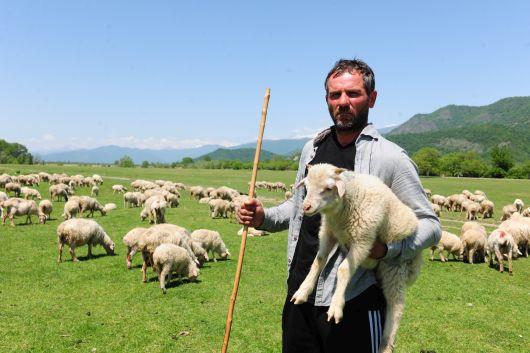Survey sheds light on Georgian farmer attitudes toward livestock traceability

The findings are in from an FAO survey of livestock producers in Georgia. When analyzed, the numbers provide important insights into the country’s livestock sector.
The survey was conducted during the month of August 2017, to gather baseline data for a major FAO project on livestock traceability, financed by the Swiss Agency for Development Cooperation and the Austrian Development Cooperation. The aim was to identify the challenges facing livestock farmers today, and gauge farmer attitudes towards animal health interventions and communication channels.
Cattle are the predominant type of livestock husbandry, with the vast majority of farmers in all regions owning them in different numbers. Ownership of pigs, buffalo, sheep and goats, however, is unevenly distributed throughout the country. On average, livestock producers own 3.8 head of cattle, 2.7 pigs, 19.5 sheep, 6.4 goats, and 2.4 buffalo.
Among other things, the farmers’ responses showed ambivalence about the importance of animal traceability and health interventions. The study highlighted that the majority of livestock farmers do not perceive a connection between animal health care on the one hand, and food safety and human health on the other. This finding is important, because by consuming about 98 percent of the animal products they produce, household members are the first to be affected by zoonotic diseases transmitted from animals to humans.
"By consuming about 90 percent of the animal products they produce, farm household members are the first to be affected by diseases transmitted from animals to humans."
Farmers were asked to rate their knowledge of animal diseases on a scale of zero to 10, where 0 means no knowledge and 10 indicates advanced understanding of animal health. About one-third (29 percent) of respondents admitted to knowing nothing about animal diseases. Nevertheless, more than two-thirds of farmers (72 percent) recognized the benefits of vaccinating their animals.
“Only with proper understanding of farmer attitudes can the project identify and address the knowledge gaps and misconceptions,” said FAO project officer Dragan Angelovski. “This will affect the success of animal identification and registration activities, ongoing animal health interventions, and noncompliance with regulations.”
The assessment provides important data for the National Food Agency and Ministry of Agriculture and the NAITS team,” Angelovski added.
Gender-based differences are clear when it comes to livestock husbandry. While men bring feed or take livestock to pastures, women do the milking. The survey found that men and women typically spend about the same amount of time on livestock care. Women and men are also equally engaged in activities related to animal health, and managing the income generated from selling livestock products.
Communicating with farmers
TV emerged as a main source of information about current events, with 82 percent of respondents ranking it as their preferred choice. It was also considered to be the most trusted source of news.
Second to television in popularity was word-of-mouth communication, preferred by 24 percent of farmers. The internet was preferred by less than one-fourth of respondents. The most visited online resources are social networks such as Facebook and Skype, which are used mainly for communicating with relatives living abroad.
For matters relating to animal health, most farmers said they trusted veterinarians above anyone else.
19 December 2017, Tbilisi, Georgia
